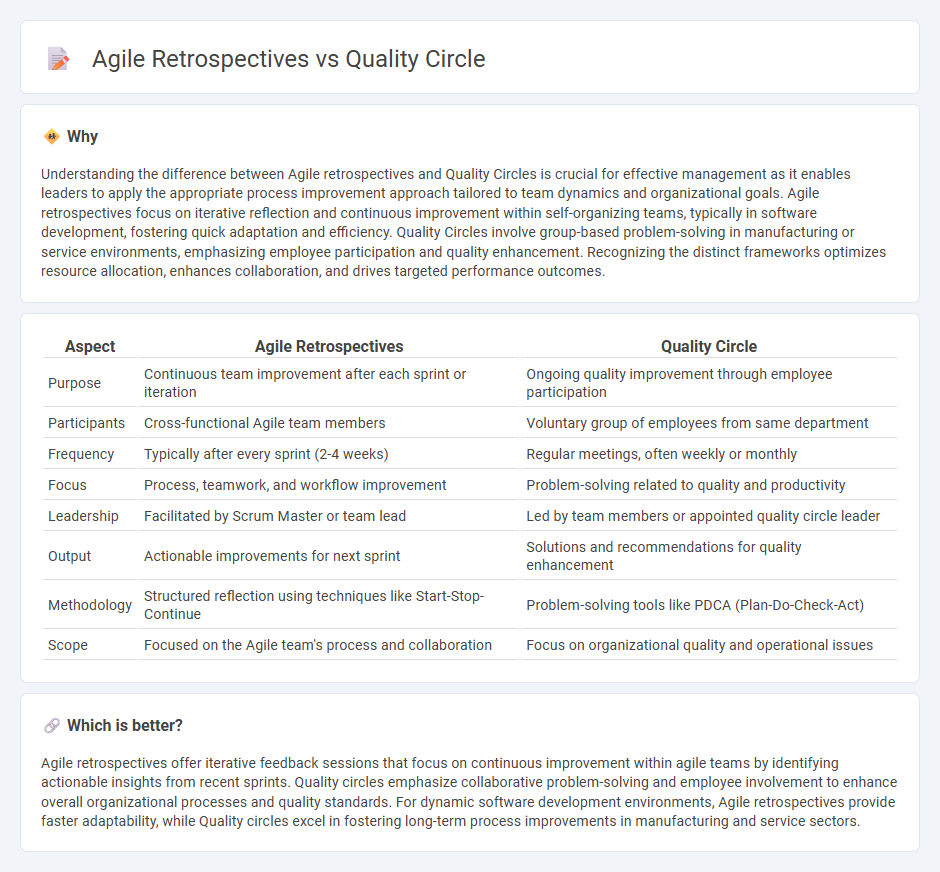
Agile retrospectives focus on continuous improvement by regularly reflecting on team processes and outcomes within software development cycles. Quality circles emphasize employee collaboration and problem-solving to enhance overall organizational quality and productivity across various industries. Discover how integrating both approaches can elevate team performance and operational excellence.
Why it is important
Understanding the difference between Agile retrospectives and Quality Circles is crucial for effective management as it enables leaders to apply the appropriate process improvement approach tailored to team dynamics and organizational goals. Agile retrospectives focus on iterative reflection and continuous improvement within self-organizing teams, typically in software development, fostering quick adaptation and efficiency. Quality Circles involve group-based problem-solving in manufacturing or service environments, emphasizing employee participation and quality enhancement. Recognizing the distinct frameworks optimizes resource allocation, enhances collaboration, and drives targeted performance outcomes.
Comparison Table
| Aspect | Agile Retrospectives | Quality Circle |
|---|---|---|
| Purpose | Continuous team improvement after each sprint or iteration | Ongoing quality improvement through employee participation |
| Participants | Cross-functional Agile team members | Voluntary group of employees from same department |
| Frequency | Typically after every sprint (2-4 weeks) | Regular meetings, often weekly or monthly |
| Focus | Process, teamwork, and workflow improvement | Problem-solving related to quality and productivity |
| Leadership | Facilitated by Scrum Master or team lead | Led by team members or appointed quality circle leader |
| Output | Actionable improvements for next sprint | Solutions and recommendations for quality enhancement |
| Methodology | Structured reflection using techniques like Start-Stop-Continue | Problem-solving tools like PDCA (Plan-Do-Check-Act) |
| Scope | Focused on the Agile team's process and collaboration | Focus on organizational quality and operational issues |
Which is better?
Agile retrospectives offer iterative feedback sessions that focus on continuous improvement within agile teams by identifying actionable insights from recent sprints. Quality circles emphasize collaborative problem-solving and employee involvement to enhance overall organizational processes and quality standards. For dynamic software development environments, Agile retrospectives provide faster adaptability, while Quality circles excel in fostering long-term process improvements in manufacturing and service sectors.
Connection
Agile retrospectives and Quality Circles both emphasize continuous improvement by fostering collaborative team reflection and problem-solving processes. Agile retrospectives focus on iterative feedback within project cycles to identify inefficiencies and implement actionable changes, while Quality Circles systematically analyze work-related issues to enhance quality and productivity. Integrating these methodologies promotes a culture of ongoing learning and operational excellence in management practices.
Key Terms
Continuous Improvement
Quality circles involve small groups of employees who meet regularly to identify and solve workplace problems, fostering continuous improvement through collaborative problem-solving and root cause analysis. Agile retrospectives are iterative team meetings held at the end of each sprint, emphasizing reflection on processes and teamwork to implement actionable improvements swiftly. Explore how integrating quality circles and agile retrospectives can drive sustained organizational growth and efficiency.
Team Collaboration
Quality circles enhance team collaboration through structured problem-solving and continuous improvement meetings involving frontline employees to address workplace challenges. Agile retrospectives facilitate iterative reflection among cross-functional teams, promoting transparency, adaptation, and shared accountability to optimize sprint outcomes. Explore deeper insights into how both methods uniquely boost team synergy and productivity.
Feedback Mechanism
Quality circles emphasize continuous improvement through collaborative problem-solving, where regular feedback loops identify operational inefficiencies and foster team ownership. Agile retrospectives prioritize iterative reflections at the end of sprint cycles, encouraging transparent communication and adaptive changes based on team feedback. Explore deeper insights on how these feedback mechanisms drive organizational performance and team dynamics.
Source and External Links
What is a Quality Circle: Benefits and Process - Quality Circles are groups of employees who identify, analyze, and solve quality issues through continuous improvement and problem-solving techniques.
Quality Circle: A Guide to Employee-Driven Process Improvement - This guide explains how Quality Circles work as employee-driven groups that enhance productivity and quality through traditional and modern problem-solving methods.
Quality Circle - A quality circle is a small, formal group of workers who meet regularly to identify and resolve workplace issues, focusing on quality, productivity, and employee development.
 dowidth.com
dowidth.com